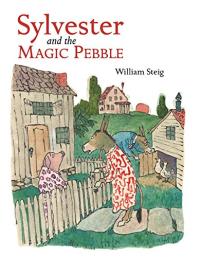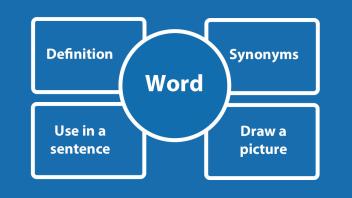Key Information
Focus
When To Use This Strategy
Appropriate Group Size
What is a word map?
A word map is a visual organizer that promotes vocabulary development. Most word map organizers engage students in developing a definition, synonyms, antonyms, and a picture for a given vocabulary word or concept. Word maps can be used effectively with classroom read-alouds and word walls.
Why use word maps?
- They help students develop their understanding of a word.
- They help students think about new terms or concepts in several ways by asking questions such as: What is it? What is it like? What are some examples?
- They help student build upon prior knowledge and visually represent new information.
- Word maps support oral and reading comprehension.
How to use word maps
- Introduce the vocabulary word and the word map template to the students.
- Teach them how to use the map by putting the target word in the central box.
- Ask students to suggest words or phrases to put in the other boxes which answer the following questions:
- What is it?”
- What is it like?
- What are some examples?
- Encourage students to use synonyms, antonyms, and a picture to help illustrate the new target word or concept.
- Model how to write a definition using the information on the word map.
Watch an academic vocabulary lesson (whole class)
This video walks you through a 3-step routine for teaching academic vocabulary to students in grades PreK-1. (Institute of Education Sciences)
Watch a nonfiction read-aloud demonstration
Collect resources
See an example of a completed word map for the vocabulary word “harbor” and examples of using synonyms, antonyms and the student’s description. See example ›
Differentiate instruction
For second language learners, students of varying reading skill, and younger learners
- Give students who need extra help the chance to work with a partner.
- Allow students to use pictures to illustrate when appropriate.
- Adjust the number of words students need to map.
- Provide students with sentences each containing the target word. The sentences should provide enough context clues to enable students to complete a word map.
- Instruct advanced students to refer to the dictionary, encyclopedia or other reference books for help in completing the word map. Ask them to compare their definitions and the dictionary definition.
Extend the learning
Math
See how to use word maps to teach new and unfamiliar terms in various math units. See example ›
Science
Explore how to use word maps to teach unfamiliar vocabulary terms in science units. See example ›
Social Studies
Learn how word maps can be integrated within a geography lesson to teach new concepts and terms. See example ›
See the research that supports this strategy
Baumann, J. F., & Kameenui, E. J. (1991). Research on vocabulary instruction: Ode to Voltaire. In J. Flood, J. D. Lapp, & J. R. Squire (Eds.), Handbook of research on teaching the English Language Arts (pp. 604-632). New York: Macmillan.
Colorín Colorado. (2007). Using Science to Develop ELLs Language Skills .
Jones, R. (2007). Strategies for Reading Comprehension: Vocabulary Word Maps .
Jones, R.C., & Thomas, T.G. (2006). Leave No Discipline Behind. The Reading Teacher, 60(1), 58-64.
Schwartz, R. M., & Raphael, T. E. (1985). Concept of definition: A key to improving students’ vocabulary. The Reading Teacher, 39, 198-205
Texas Education Agency. (2002). Teaching Word Meanings as Concepts .
Children’s books to use with this strategy

The Tale of Peter Rabbit

Big, Bigger, Biggest

